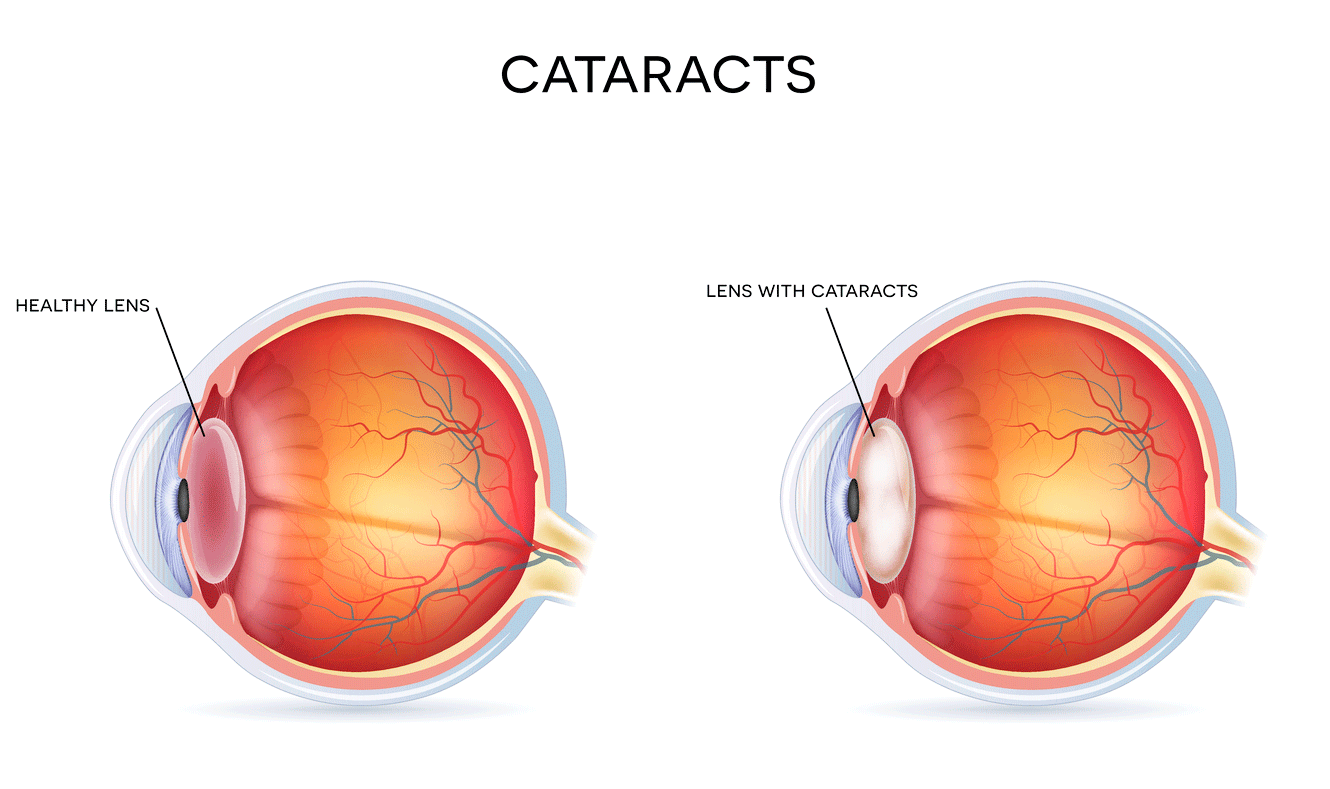A Guide To Cataracts
12 April 2019

What is a cataract?
A cataract is a visually impairing condition in which the lens becomes ‘cloudy’ and is often described as looking through frosted glass.
This clouding can occur in one or both eyes and develops gradually; which over time can result in complete blindness.
Affecting roughly 30% of people aged 65 and over, cataracts can be prevented and treated with Refractive Lens Exchange.
In this article we look into:
- The symptoms of cataracts
- The causes of cataracts
- Treatment for cataracts
What are the symptoms of cataracts?
A cataract develops slowly and can become uncomfortable in its advanced stages. The most common symptom of a cataract is the clouding of the lens. This will start in a small part of the eye and grow larger, until it completely impairs vision.
Medical advice should be sought after once a cataract begins to form. Once this happens, the condition will not go away on its own and will worsen over time.
Signs and symptoms of cataracts include:
- Cloudy or blurry vision
- Decreased sensitivity to colour distinction
- Difficulty with vision at night
- Sensitivity to light and glare
- Seeing "halos" around lights
- Frequent changes in prescription
- Double vision
Due to the length of time it can take for a cataract to develop, it can go unnoticed. It is vital to attend regular eye examinations, so the cataract can be detected in the early stages.
What causes cataracts?
Most cases of cataracts are age-related; however there are several additional factors that can lead to the growth of a cataract. These are either genetic or linked to one’s lifestyle.
A cataract develops from the build-up of protein that ‘clumps up’; reducing the amount of light reaching the retina. When a cataract is in the initial stages, it is small and the cloudiness only affects a small part of the lens. As the cataract progresses, this cloudiness will start to take up more and more of the lens.
The lens is responsible for focusing light through the vitreous humor (clear gel-like substance that fills the back of the eye near the retina). These light rays land on the retina and transforms them into electrical impulses, which are carried by the optic nerve to the brain and interpreted into images.
If the lens is clouded by a cataract, this light is scattered, so it can no longer focus correctly.

Here are some of the main causes of cataracts:
- Over exposure to ultraviolet light
- Diabetes
- Obesity
- Smoking
- Prolonged use of corticosteroid medications
- Statin medicines used to reduce cholesterol
- Previous eye injury or inflammation
- Previous eye surgery
- Hormone replacement therapy
- Excessive alcohol consumption
- High myopia (short-sightedness)
- Family history
Is there a treatment for cataracts?
In the early stages of cataracts, many people manage the symptoms with the use of visual aids. However as the condition progresses, Refractive Lens Exchange is required to remove the affected lens.
What is Refractive Lens Exchange?
Refractive Lens Exchange, or as its most commonly known Lens Replacement Surgery, is a simple procedure; in which the natural lens is removed and replaced with an artificial one.
It’s the most commonly performed procedure in the world (can you believe?) and can be completed in less than ten minutes by some of our highly experienced surgeons.
The procedure is suitable for those living with long-sightedness, short-sightedness, presbyopia, astigmatism and cataracts. In order to correct all of these impairments at once, a multifocal lens will be applied.
Multifocal lenses are the most popular option to tackle presbyopia and are designed to provide visual clarity at four different focal points, instead of the single focal point offered by the NHS.
What happens during Refractive Lens Exchange?
Eye drops are administered prior to surgery to dilate the pupil, as well as local anaesthetic to numb the area, allowing for optimum comfort.
During the procedure, patients will be asked to focus on three lights for the duration of the procedure – it’s as simple as that!
The surgeon will start by carefully removing the natural lens with the use of ultrasound. The artificial lens is then gently put into place. Contrary to popular belief, the lens cannot be felt inside the eye after surgery.
Surgery lasts anything from 10 – 30 minutes, depending on how advanced the cataract is (in most cases it’s a very quick procedure).
A patch will be placed on the eye after surgery and patients are taken to a recovery room.
Recovering from Refractive Lens Exchange
Recovery from eye surgery is surprisingly quick. Effective aftercare is very important in order to reduce the risk of infection. Eyes may be sensitive after a cataract removal, so it’s important to follow the advice of the surgeon.
Driving is not possible after surgery. It is advised that driving should only commence once a registration plate can be read from 20 feet away- this usually takes two to three days.
Eye drops will be provided within an aftercare package. It’s important that these are used exactly as instructed by the surgeon, to ensure healing is effective. These eye drops will usually require everyday use, for a course of four weeks.
After lens surgery it is important to protect eyes from light, as they will be more sensitive. Wearing sunglasses for a few days following the procedure should be sufficient.
Lastly, it is vital that all aftercare appointments are attended, as instructed by the clinic.
Back to Blog
